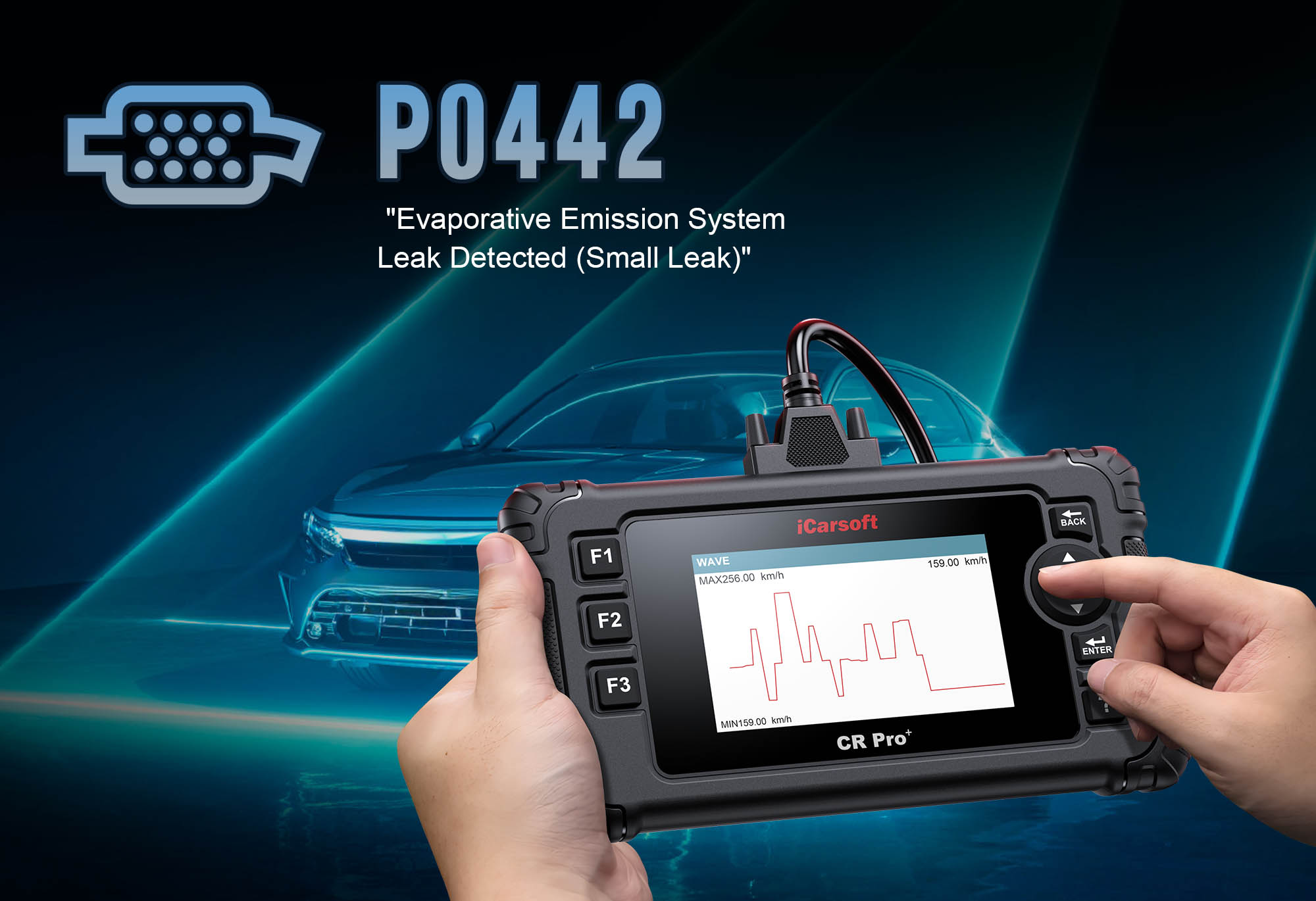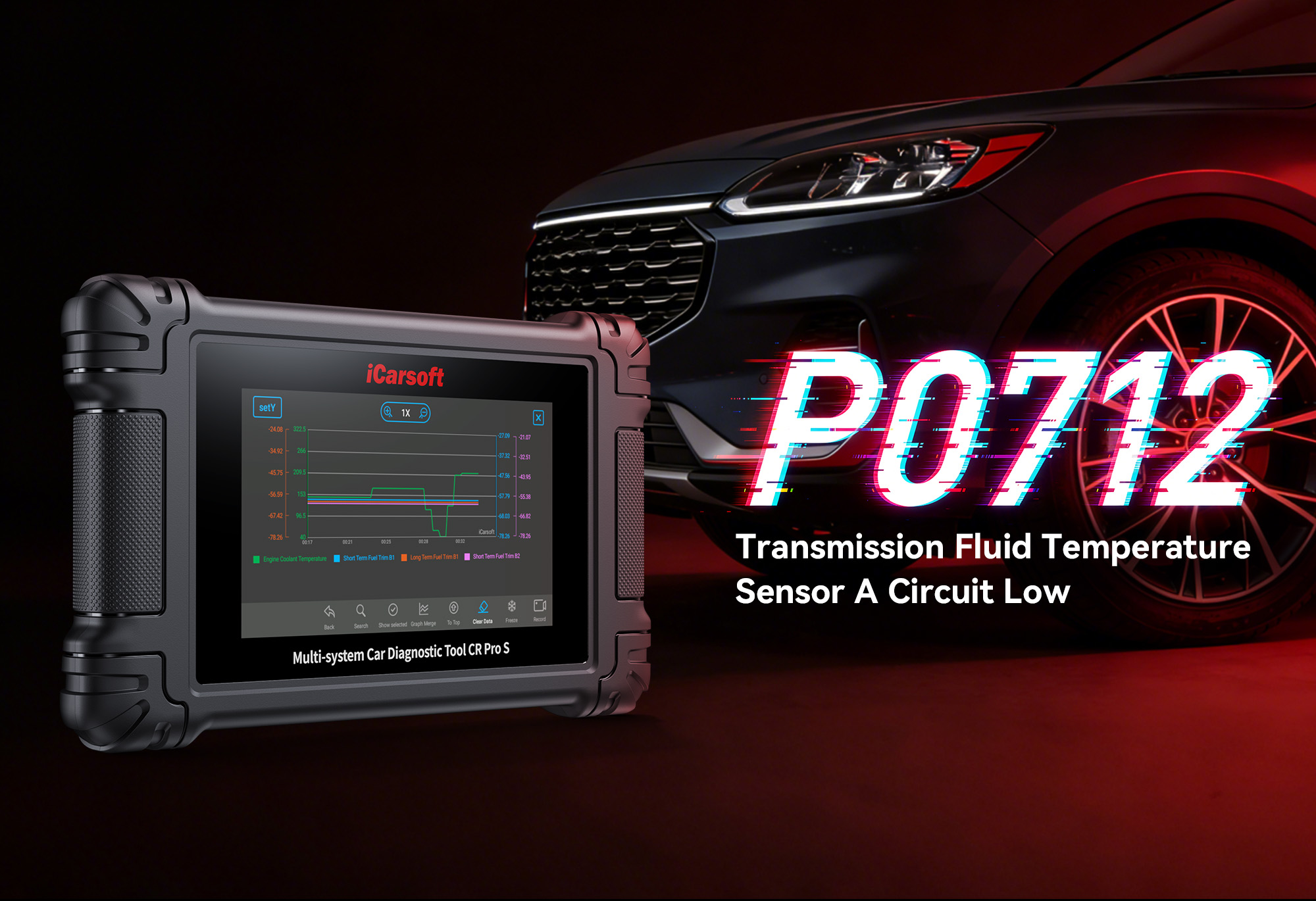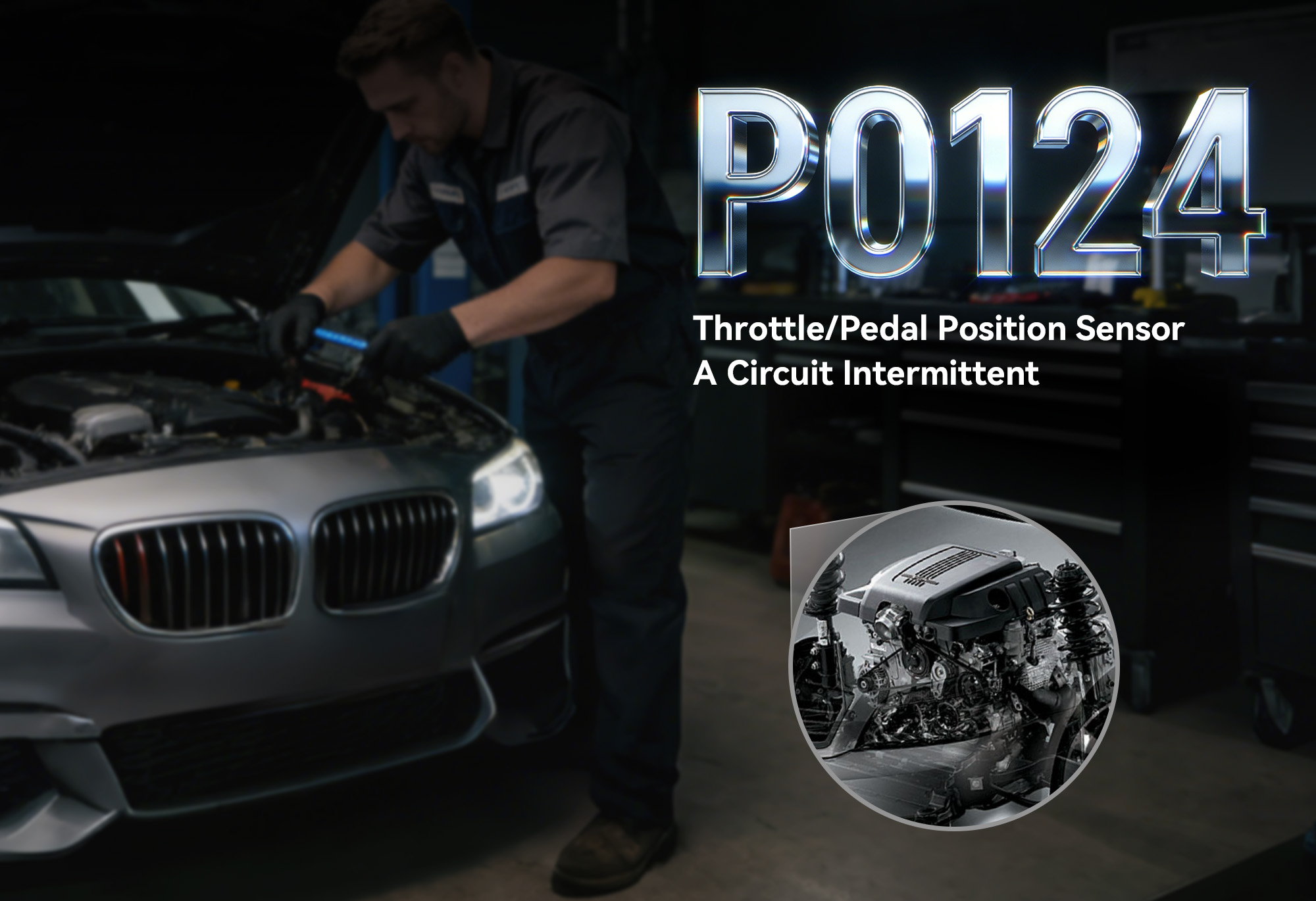Diagnose & Clear P0442 with iCarsoft CR Pro+: Fix EVAP System Small Leak Issues
If your check engine light illuminates and a scan returns P0442, your vehicle’s Evaporative Emissions (EVAP) system is signaling a subtle but persistent problem. This generic OBD-II code stands for "Evaporative Emission System Small Leak Detected"—indicating a tiny breach (typically 0.020 inches or smaller) in the system designed to trap and recycle fuel vapors, preventing them from escaping into the atmosphere.
Unlike larger EVAP leaks (flagged by P0455), P0442 involves micro-sized openings—think pinholes in hoses or worn seals—that allow minimal vapor escape. These leaks are harder to detect but still critical: they compromise emissions compliance, slightly reduce fuel efficiency, and can escalate into larger issues if ignored.
Basic scanners may only confirm "a small EVAP leak" but lack the precision to locate such tiny flaws. The iCarsoft CR Pro+—with its advanced pressure monitoring, EVAP-specific diagnostics, and professional-grade leak detection—solves this. Let’s walk through how to diagnose and resolve P0442.
Why It Matters
Ignoring P0442’s "small leak" label leads to hidden consequences that grow over time:
-
Emissions Non-Compliance: Even micro-vapor leaks push hydrocarbon (HC) levels above legal limits, guaranteeing a failed state inspection—resulting in re-test fees ($20–$50) and potential fines.
-
Fuel Waste: Unrecovered fuel vapors reduce mileage by 1–2%—over 10,000 miles, this adds up to 10–20 gallons of wasted gas (≈$30–$80, depending on fuel prices).
-
Leak Escalation: Micro-cracks in hoses or seals worsen with temperature changes (expansion/contraction) and vibration—what starts as P0442 often becomes a larger P0455 leak, requiring costlier repairs (e.g., $300+ for a new charcoal canister).
-
Component Damage: Moisture or debris can enter the EVAP system through leaks, damaging critical parts like the Purge Solenoid ($80–$150) or Pressure Sensor ($50–$120).
-
Intermittent Performance Issues: While P0442 doesn’t cause rough idle or power loss, it can trigger false fault codes in other systems (e.g., EGR) as the ECM compensates for vapor loss.
Understanding P0442: Causes & Key Symptoms
To tackle P0442 effectively, first distinguish its unique traits from other EVAP codes—this narrows down the root cause quickly:
Key Symptoms of P0442
-
Persistent Check Engine Light: Triggers after 2+ consecutive startup cycles where the ECM detects vapor loss—may turn off temporarily (e.g., in humid weather) but reappear.
-
Faint Fuel Odor: A subtle gasoline smell near the rear of the vehicle (especially after refueling)—far less noticeable than the strong fumes from P0455’s large leaks.
-
Marginal Fuel Efficiency Drop: Hard to detect without tracking mileage—you’ll notice slightly more frequent trips to the gas station.
-
Intermittent Triggers: Appears/disappears based on weather (cold/hot temperatures worsen micro-cracks) or driving patterns (highway speeds increase vapor pressure).
-
Failed Emissions Tests: Inspectors will flag P0442 immediately—HC levels often exceed limits by 5–10% (just enough to fail).
Common Causes of P0442
|
Cause
|
Description
|
|
Worn Gas Cap Seal
|
Dried, cracked, or debris-clogged rubber gaskets on the gas cap—responsible for 20% of P0442 cases. Fails to seal the tank, allowing micro-vapor escape.
|
|
Pinholes in EVAP Hoses
|
Micro-cracks from heat (engine bay/hot exhaust), age (5+ years), or rodent nibbles—most common in flexible hoses connecting the gas tank to the charcoal canister.
|
|
Loose Hose Connections
|
Slightly loose clamps (from vibration) create tiny gaps—vapors escape only when the system is pressurized (e.g., after refueling).
|
|
Charcoal Canister Degradation
|
Fine cracks in the canister’s plastic housing (from undercarriage impact or corrosion) or internal carbon bed damage—releases stored vapors slowly.
|
|
EVAP Solenoid Seal Wear
|
Deteriorated O-rings in the Purge Solenoid (engine-mounted) or Vent Solenoid (canister-mounted)—common in vehicles over 6 years old.
|
|
Fuel Filler Neck Gasket Issues
|
Worn or compressed rubber gaskets where the filler neck connects to the gas tank—leaks occur when the tank is full (higher vapor pressure).
|
Why iCarsoft CR Pro+ Excels at Diagnosing P0442
The CR Pro+ outperforms basic scanners with features tailored to detecting micro-leaks—critical for P0442, where even 0.05 kPa pressure changes matter:
High-Resolution Pressure Monitoring
Measures pressure fluctuations as small as 0.05 kPa—captures leaks too subtle for standard scanners (which miss changes under 0.5 kPa).
Extended Leak Detection Test
Runs a 20-minute pressurized test (vs. 5–10 minutes on basic tools) to catch slow, intermittent leaks that only appear over time.
Smoke Test Integration
Connects to professional smoke machines via its auxiliary port—visualizes micro-leaks in hoses, canisters, or solenoid seals (faint wisps of smoke).
EVAP System Mapping
Preloaded with detailed diagrams for 65+ makes (Mercedes-Benz C-Class, Subaru Outback, Dodge Ram)—highlights common micro-leak points.
Canister Purge Efficiency Tests
Analyzes vapor flow through the charcoal canister—detects internal degradation that causes slow vapor leakage (basic tools miss this).
Historical Pressure Logging
Records pressure changes over hours—captures leaks that appear only during temperature swings (cold mornings/hot afternoons) or driving.
Step-by-Step: Diagnose P0442 with iCarsoft CR Pro+
-
1. Connect & Confirm the Code
1. Plug the CR Pro+ into your vehicle’s OBD-II port (under the dashboard) and power it on.
2. Select your vehicle via Auto VIN Scan (reads your VIN in 2–3 seconds) or manual entry (make/model/year—critical for EVAP system specificity).
3. Navigate to Engine > Fault Codes > Read Codes to confirm P0442. Tap Code Details for vehicle-specific insights (e.g., "Subaru: EVAP Pressure Drop >0.3 kPa Over 15 Minutes" or "Mercedes-Benz: Small Leak in Tank Vent Circuit").
-
2. Check for Related EVAP Codes
P0442 rarely appears alone—scan for companion faults to narrow the root cause:
- P0440: General EVAP Malfunction (systemic wear, e.g., aging hoses + solenoid seals)
- P0446: Vent Solenoid Circuit Fault (solenoid not sealing, worsening leaks)
- P0455: Large EVAP Leak (indicates multiple issues—fix P0455 first, then recheck P0442)
- P0452/P0453: EVAP Pressure Sensor Low/High Voltage (faulty sensor masking leak size)
Multiple codes = address all issues, not just the smallest leak.
-
3. Inspect the Gas Cap First (Easiest Fix)
A worn gas cap seal causes 1 in 5 P0442 cases—verify with the CR Pro+ to avoid unnecessary repairs:
1. Remove the gas cap and inspect the rubber gasket:
- Look for cracks, dryness, or debris (wipe clean with a damp cloth if dirty).
- Check if the gasket is compressed or missing sections (common in caps over 3 years old).
2. Tighten the cap until you hear 3–4 clicks (proper sealing position).
3. Navigate to Special Functions > EVAP > Gas Cap Seal Test—the CR Pro+ runs a 5-minute pressure test.
4. Results:
- Test passes = cap is good; move to other components.
- Test fails = replace with an OEM cap (use the scanner’s Part Lookup for specs, e.g., Subaru 42021AG010).
-
4. Run the Extended EVAP Leak Test
The CR Pro+’s precision test identifies even micro-leaks that basic tools miss:
1. Prep the vehicle:
- Ensure the gas tank is 1/4 to 3/4 full (extremes disrupt pressure stability).
- Turn off the engine and close all doors (pressure changes from open doors affect results).
2. Navigate to Special Functions > EVAP > Extended Leak Detection.
3. Follow on-screen prompts: The scanner closes the Vent Solenoid, pressurizes the system to 2.5 kPa, and monitors for 20 minutes.
4. Results:
- Pressure holds steady = no leak (P0442 may be a false code from a previous loose cap).
- Slow pressure drop (0.3–1 kPa over 20 minutes) = small leak (proceed to locate it).
-
5. Locate the Leak with Visual Inspection & EVAP Maps
Use the CR Pro+’s Component Location tool to find key EVAP parts—focus on these micro-leak hotspots:
EVAP Hoses:
- Trace hoses from the gas tank to the charcoal canister (follow the scanner’s diagram).
- Flex hoses gently in bright light—look for tiny pinholes (light shines through).
- Check clamps: Tighten loose ones with a screwdriver; replace corroded clamps (they won’t hold tension).
- Squeeze hoses—hard, inflexible sections (dry rot) often hide micro-cracks.
Charcoal Canister:
- Located near the rear axle—inspect seams with a flashlight for hairline cracks.
- Check the vent valve connection: Worn O-rings here cause slow leaks.
Purge/Vent Solenoids:
- Purge Solenoid (engine/firewall-mounted): Check for oil-contaminated O-rings (engine leaks damage seals).
- Vent Solenoid (canister-mounted): Remove and inspect the rubber O-ring for tiny tears.
Fuel Filler Neck:
- Check the gasket where the neck connects to the tank—look for compression wear or cracks.
-
6. Use Smoke Testing for Hidden Micro-Leaks
For elusive P0442 causes (e.g., tiny hose pinholes), pair the CR Pro+ with a smoke machine:
1. Connect the smoke machine to the EVAP system’s service port (location shown in the CR Pro+’s diagram).
2. Navigate to Special Functions > EVAP > Smoke Test Mode—the scanner closes solenoids to seal the system (prevents smoke from escaping unused ports).
3. Inject smoke at low pressure (5 psi)—too much pressure damages EVAP components.
4. Look for faint wisps of smoke:
- Around hose connections = loose clamps or worn O-rings.
- On canister seams = cracked housing.
- At solenoid bases = degraded seals.
5. Mark leak points with tape—repair immediately (e.g., splice hoses, replace O-rings).
-
7. Test EVAP Solenoids for Weak Seals
The CR Pro+’s bi-directional tests identify solenoids with worn seals that cause slow leaks:
Vent Solenoid Test:
1. Go to Special Functions > EVAP > Vent Solenoid Activation.
2. Activate the solenoid (should seal the system) and monitor pressure via live data.
3. Slow pressure drop (>0.2 kPa in 5 minutes) = weak seal—replace the solenoid.
Purge Solenoid Test:
1. Repeat for the Purge Solenoid—select Purge Solenoid Activation.
2. Ensure the solenoid holds pressure when closed (no drop within 5 minutes).
3. Use the CR Pro+’s Part Lookup for OEM replacements (e.g., Dorman 911-082 Vent Solenoid).
-
8. Repair & Clear P0442
Fix the root cause based on diagnostics—prioritize low-cost, easy fixes first:
- Worn Gas Cap: Replace with OEM (avoid generic caps—they don’t seal properly).
- Pinhole Hoses: Cut out damaged sections and splice with EVAP-rated heat-shrink connectors (resistant to fuel vapors).
- Loose Clamps/O-Rings: Tighten clamps or replace O-rings (use silicone-based O-rings for durability).
- Faulty Solenoids: Swap with OEM parts—torque to specs (5–8 ft-lbs, provided by the scanner).
- Canister Cracks: Use EVAP-specific sealant for small cracks; replace the canister if damage is severe.
Clear the code: Navigate to Engine > Fault Codes > Clear Codes to delete P0442 and related EVAP faults.
-
9. Verify the Repair
Confirm the micro-leak is fixed to avoid reoccurrence:
1. Re-run the Extended EVAP Leak Test—pressure should hold steady for 20 minutes.
2. Take a 30-minute test drive (include highway and city driving) to let the ECM recheck the EVAP system.
3. Rescan with the CR Pro+—no return of P0442 = successful repair.
4. Check emissions readiness: Navigate to Readiness Monitors—ensure the EVAP monitor is "Ready" for state inspections.
5. Monitor mileage for 1–2 weeks—improved fuel efficiency confirms no remaining leaks.
Preventing P0442 Recurrence
The CR Pro+ helps maintain a tight EVAP system long-term, avoiding future micro-leaks:
-
Gas Cap Maintenance: Clean the cap’s gasket monthly with mild soap and water; replace every 3–5 years (set a reminder in the CR Pro+’s Service Scheduler).
-
Hose Inspections: Check EVAP hoses during 15,000-mile services—replace any showing dry rot, flexibility loss, or surface cracks.
-
Solenoid Care: Apply dielectric grease to solenoid electrical connectors annually to prevent corrosion (use the CR Pro+’s Component Tips for location guidance).
-
Seasonal Leak Tests: Run the Extended EVAP Leak Test before extreme temperature changes (winter cold/summer heat)—catches expanding micro-cracks early.
-
Canister Protection: Avoid driving over debris or curbs that could damage the undercarriage-mounted charcoal canister.
-
Refueling Habits: Don’t top off the gas tank (overfilling pushes fuel into the EVAP system, damaging seals) and always tighten the cap until it clicks 3–4 times.
StepAction1Connect CR Pro+, confirm P0442, and review vehicle-specific code details2Scan for related EVAP codes (P0440, P0446, etc.)3Test gas cap seal; replace if faulty4Run Extended EVAP Leak Test to confirm micro-leak5Locate leaks via visual inspection (using EVAP maps)6Use smoke testing for hidden micro-leaks (CR Pro+ integration)7Test Purge/Vent Solenoids for weak seals8Repair root cause and clear P04429Verify repair with extended leak test, test drive, and re-scan
Conclusion
P0442’s "small leak" label can be deceptive—it’s not just an emissions nuisance, but a warning sign of潜在 component wear. The iCarsoft CR Pro+ eliminates guesswork with tools designed for micro-leak detection: high-resolution pressure monitoring to catch tiny pressure drops, smoke test integration to visualize hidden flaws, and vehicle-specific maps to target common issues.
Whether you’re replacing a $20 gas cap, patching a $5 hose, or swapping a $80 solenoid, the CR Pro+ ensures you fix the root cause—not just mask the code. By following this guide, you’ll restore emissions compliance, improve fuel efficiency, and prevent small leaks from becoming costly repairs—all with professional-grade accuracy, no dealer visit required.
FAQs About P0442 Code
Q: Can I drive my vehicle with P0442?
A: Yes, but only short-term (2–3 weeks). P0442 doesn’t affect engine performance, but long-term driving allows micro-leaks to worsen (e.g., pinholes become cracks) and risks failed emissions tests. Fix it before your next inspection to avoid fines.
Q: Will a fuel system cleaner fix P0442?
A: No. Fuel system cleaners target carbon buildup in the engine or fuel injectors—they have no effect on EVAP system leaks (pinholes, worn seals, or loose clamps). The only fix is repairing the physical leak, which the CR Pro+ helps locate.
Q: Why does P0442 come back after I cleared the code?
A: Common reasons include: 1) Unrepaired secondary leaks (e.g., fixed a hose but missed a solenoid O-ring), 2) Using non-EVAP-rated parts (e.g., standard heat-shrink instead of fuel-resistant), 3) Failing to reset the EVAP monitor (drive 30 minutes after clearing codes). Re-run the CR Pro+’s Extended Leak Test to find hidden issues.
Q: How much does it cost to fix P0442?
A: Costs vary by cause: Gas cap replacement = $20–$60 (DIY); Hose repair = $5–$30; Solenoid replacement = $80–$150 (DIY); Charcoal canister replacement = $300–$800 (professional). The CR Pro+ helps avoid overspending by identifying low-cost fixes first.





